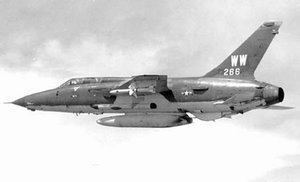F-105 Thunderchief
|
|
| Republic F-105D Thunderchief | ||
|---|---|---|

| ||
| Description | ||
| Role | Single-seat fighter-bomber | |
| Crew | One | |
| First flight | 1955 | |
| Entered service | 1958 | |
| Manufacturer | Republic Aviation Company | |
| Dimensions | ||
| Length | 64 ft 3 in | 19.58 m |
| Wingspan | 34 ft 11.25 in | 10.65 m |
| Height | 19 ft 8 in | 5.99 m |
| Wing area | 385 ft² | 35.8 m² |
| Weights | ||
| Empty | 27,500 lb | 12,474 kg |
| Loaded | 35,637 lb | 16,165 kg |
| Maximum takeoff | 52,546 lb | 23,834 kg |
| Powerplant | ||
| Engine | Pratt & Whitney J75 afterburning turbojet | |
| Thrust | 26,500 lbf | 118 kN |
| Performance | ||
| Maximum speed | 1,420 mph (Mach 2.15) | 2,285 km/h |
| Combat range | 1,252 km | |
| Ferry range | 2,208 miles | 3,553 km |
| Service ceiling | 48,500 ft | 14,783 m |
| Rate of climb | 34,000 ft/min | 10,500 m/min |
| Avionics | ||
| Avionics | AN/ASG-19 'Thunderstick' radar | |
| Armament | ||
| Guns | 1 × 20 mm M61 Vulcan cannon, 1028 rounds | |
| Bombs | Internal bay and five external pylons for a total of 14,000 lb (6,700 kg) of general-purpose bombs up to M118 3,000 lb (1,400 kg) size, or up to three nuclear bombs | |
| Missiles | AIM-9 Sidewinder and AGM-12 Bullpup; later AGM-45 Shrike and AGM-78 Standard | |
The Republic F-105 Thunderchief was a single-seat, supersonic fighter-bomber used by the United States Air Force. It saw extensive service during the Vietnam War.
Development
The F-105 began development as a company-funded design, the AP-63FBX (Advanced Project 63 Fighter Bomber, Experimental). After a back-and-forth with the USAF, which contracted and then radically curtailed the initial production order, the design was approved in October 1953. The first flight of the YF-105A prototype was made 22 October 1955.
The original plan was for the F-105 to use a single Allison J71 turbojet, but the YF-105A used the Pratt & Whitney J57 instead. Both aerodynamic problems with transonic drag and insufficient power led the production aircraft to adopt the Pratt & Whitney J75. A redesign of the fuselage to conform to the Area rule, along with the production J75 engine and new variable intakes, enabled the resulting F-105B to reach Mach 2.
The F-105 was a mid-wing monoplane with a 45° swept wing and tail surfaces. The single engine was fed by two intakes in the wing roots, leaving the nose free for a radome for the multi-mode radar. At the time the F-105 was the largest single-seat combat aircraft ever built. Its capacious fuselage provided room for tanks for 1,160 US gallons (4,400 liters) of fuel and a 15 ft 10 in (4.8 m) weapons bay, originally intended for a single nuclear weapon. Four underwing and one fuselage stores pylons were provided, and a single T-171E3 20 mm rotary cannon was installed in the port side of the nose, with a tank for 1,028 rounds of ammunition.
The F-105B entered USAF service with the Tactical Air Command's 335th Tactical Fighter Squadron on 27 May 1958. It received the official popular name Thunderchief, reminiscent of Republic's previous P-47 Thunderbolt, F-84 Thunderjet, and F-84F Thunderstreak. Over 800 were produced before production ended in 1964.
Although built for a projected European conflict with the Soviet Union and based in Western Germany (http://members.aol.com/_ht_a/dgtheskier/thud-eur.htm), the F-105 saw extensive service in the Vietnam War. During the first four years of the war, F-105s were responsible for over 75% of air strikes against North Vietnam. While used primarily in the bomber role, it was credited with 27.5 kills of North Vietnamese aircraft. It was nicknamed the "Thud" by its pilots. 385 were lost in Vietnam, 334 of those in combat.
The "Thud" was phased out of active service by 1969, replaced by the F-4 Phantom II in the strike role, although Wild Weasel F-105G aircraft remained until the end.
The Thunderchief was rapidly withdrawn from USAF service after the end of the Vietnam War. Some aircraft remained in service with Air National Guard units, but their heavy wartime service meant that many F-105s had already reached or exceeded their service lives by the mid-1970s. The Thunderchief was officially retired on 25 February 1984.
Variants
- YF-105A: Two pre-production prototypes.
- F-105B: Initial production model; 75 built.
- JF-105B: Test aircraft re-built from RF-105B airframes; 3 converted
- F-105C: Proposed dual-control trainer; cancelled in 1957, none built
- F-105D: Definitive production model; 610 built
- F-105E: Proposed trainer version of F-105D; cancelled in 1959, none completed
- F-105F: Two-seat trainer version of F-105D, fully combat-capable; 143 built.
- EF-105F: Initial SEAD/Wild Weasel version; 86 built.
- F-105G: Two-seat Wild Weasel SEAD version, 61 built (converted from EF-105F and F-105F).
External links
- Craig Baker's F-105 Site (http://www.burrusspta.org/thud.html)
- Thud Ridge (http://www.geocities.com/Pentagon/7002/)
- F-105 Thunderchief (http://break-left.org/air/f-105.html)
- USAF Museum: F-105D (http://www.wpafb.af.mil/museum/modern_flight/mf52.htm) and F-105G (http://www.wpafb.af.mil/museum/modern_flight/mf29.htm) and general [F-105 page (http://www.wpafb.af.mil/museum/research/fighter/f105f.htm)]
- COLD WAR THUDS (http://members.aol.com/_ht_a/dgtheskier/thud-eur.htm)
| Related content | |
|---|---|
| Related development | |
| Similar aircraft | Sukhoi Su-17 |
| Designation series | |
| Related lists | List of military aircraft of the United States - List of fighter aircraft |
|
Lists of Aircraft | Aircraft manufacturers | Aircraft engines | Aircraft engine manufacturers Airports | Airlines | Air forces | Aircraft weapons | Missiles | Timeline of aviation |
